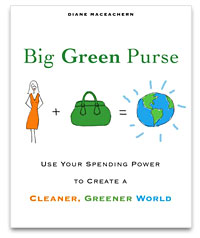
Diane MacEachern.
Mary Poppins may have had a giant carpetbag from which she could pull coat racks and potted plants. But author Diane MacEachern has something even better: A big, green purse that, she says, carries the power to influence the marketplace to “create a cleaner, greener world.”
The concept behind MacEachern’s book Big Green Purse is built on the fact that women shell out 85 cents of every dollar spent in the marketplace, and the notion that big business responds faster to consumer demand than any other market force. She says women’s consumer power — they collectively earn $2.7 billion a day, and manage billions more for their households, workplaces, and volunteer organizations — exceeds the economy of Japan. That’s quite the powerful pocketbook.
On her website, MacEachern — author of the best-selling Save Our Planet: 750 Everyday Ways You Can Help Clean Up the Earth, co-founder of Vanguard Communications, and a longtime conservationist — urges women to sign up for her One in a Million campaign, a pledge to shift at least $1,000 of the yearly household budget to more sustainable goods. That’s a shift, she emphasizes, not an additional expenditure: When choosing fruit, go for organic apples; when buying a bottle of lotion, find one without phthalates or parabens; if you must buy a car, find one that fits your needs but is fuel efficient. Still, her first piece of advice is always buy less.
While Big Green Purse is full of tips on what to buy — and what not to — MacEachern seems to have a handle on heftier topics too. Recent speaking engagements have included the Sustainable Brands ’08 conference, Book Expo America, and Marketing to Women — where the advice she gave execs from Frito-Lay to Harley-Davidson included getting third-party certification and encouraging women to buy 20 percent less (a suggestion that silenced the room, but has its merits, she says).
So can shopping really save the planet? I caught up with MacEachern to find out.
How did you decide this was the issue you wanted to focus on?
[I felt like] there was a real opportunity to protect the environment by appealing to the issues that women care about … There’s a tendency in the environmental movement to be very gender neutral … Women and men want to get to the same place, but they don’t necessarily want to get there for the same reasons. And if we started talking to women about issues that matter to women — as well as you could talk to men about issues that are more important to men — you find ways to motivate people that are very different than when it’s very gender neutral.
We’re trying to pass laws to protect the environment, and we’re trying to use the legislative process to do what the marketplace can do. So why not put those two together and … go to the people who want the answers and say, “Here’s how you can really make a difference.” You can use your money like a bright green ring and pull the marketplace in a greener direction.
There’s this notion out there that you can save the world by buying all this stuff — as long as it’s green.
In every single chapter, the very first suggestion is buy less, consume less, reduce — clearly we have to cut back on the total amount of stuff that’s being produced. But I do think that being a conscious consumer is a very powerful tool, because consumer dollars are the lifeblood of manufacturers. So we can either use them to tell manufacturers what to make or we can just continue to let manufacturers tell us what to buy.
How do you tell people what’s green?
First of all, I always say “buy less.” That’s the first thing; that’s how you most protect yourself, especially if it is some kind of a chemical product — a cleaning product, a personal care product — buy less. Women will use 15 to 25 personal care products every day. Do you need the shower gel and the soap? You don’t even think about it. And I say, if I’m talking about personal care products, line them up. Take a look at that. Can you just get rid of three? Or can you give your body a break — one day a week, just wash your face with a little soap and water and have a nice day … don’t use all that stuff.
Same thing with cleaning products. There’s now a cleaning product for virtually every surface. There’s something different for the stove, for the tile, for the kitchen sink, for the bathroom sink. All you need is Bon Ami or a little baking soda and a little kitchen soap. Take stock of what you’re doing and figure out where you can cut back. Then if you do need to buy a product, look for a third-party certification, not an industry certification.
What about buying local?
There’s always been this shroud hanging over the environmental movement that [something that’s good for the environment] is bad for the economy, but it turns out that buying local is great for the local economy. So it really makes sense, if you talk about the triple three — economic, social, and environmental — buying local hits all three.
Do you feel like environmentalists have been too quick to dismiss shopping as a route to change?
I think that the power of green consumerism has not been harnessed by the environmental movement. You’ve got all kinds of companies wanting to be green and natural and eco-friendly, and you’ve got the environmental movement saying, “Whatever you do, don’t buy anything.” … The light bulbs are a perfect example … people have to change their light bulbs anyway, so why not buy the option that makes the most sense? If you have people sit in the dark, that’s literally a turn-off.
Which is more powerful, the marketplace or political action?
It’s not either/or. People need to vote; we need to stay on our members of Congress; we need to encourage them to pass the strictest laws possible. And while we’re waiting for them to do that, the marketplace isn’t waiting for them to do it. The marketplace is going gangbusters. So why don’t we take advantage of the momentum that exists in the marketplace and direct it a little bit, and we do that by how we spend our money and how we encourage others to do it.
What are some examples of companies that have changed based on consumer demand?
Give your body a break — don’t use makeup one day a week
Save energy and reduce packaging by buying products in concentrate form
Line up your personal care products and take away three
On a regular basis, swap out a conventional meal for organic alternatives
Replace three individual cleaning products with one general-purpose cleaner
Shift 20 percent of your fashion funds to earth-friendly apparel
Certainly, the car industry is the most obvious one. There wouldn’t be hybrid cars if there weren’t consumer demand for them. And Harry Potter is a good example: 12 million copies of Harry Potter were printed on post-consumer waste recycled paper, and it’s because there was a big consumer campaign.
Look at a company like Method: There was no market for Method five years ago, and now they’re one of the fastest-growing companies in the United States. And they’re doing everything right. They’ve got a good price point. They’re available at Target. They’ve got some nice colors. It’s a cool little bottle. And it’s a relatively nontoxic product.
What is the role of big business in addressing climate issues?
Big business has got to do the right thing. Big business should right now be doing an audit of every place they use energy and figuring out, No. 1, where they can use less, how they can use energy more efficiently, and where they can get energy from a non-fossil-fuel source. Absolutely. No question about it whatsoever.
Do you think they’ll do that without pressure from the government?
I don’t know if they’ll do it without pressure from the government, but I think they’ll do it with pressure from consumers. It requires some revolutionary thinking. It requires big-picture thinking that looks at the bottom line five years from now, not just today. A lot of companies just don’t have that kind of visionary leadership at the top, and their shareholders don’t have that visionary leadership.
Who does?
Look at Whole Foods, for example. They’re 100 percent alternatively fueled. They just put a fuel cell in a store in [Connecticut] to power the store up there. They’re phasing out the bags. They’re doing a lot of great things.
And Wal-Mart — even though Wal-Mart said recently, “We’re not a green company” — what they’re doing is fantastic. Requiring people who do business with them to become more responsible is absolutely fantastic.
Where would you most like to see change — what needs to happen right away?
I wish there was more in-store explanation, so that people who were struggling with choices would have more information to help them make the right choice. The best place for that is point of purchase.
Does your book address the challenges of buying green on a budget?
First of all, there’s so much cushion in people’s budget that they don’t realize. People will say to me, “I can’t buy organic; it’s too expensive,” and then I look in their refrigerator and it’s full of bottled water. They may be spending $10 to $15 a week on bottled water, but they don’t want to spend $6 for a gallon of organic milk.
Do you worry that demand for greener products is just putting more and more products out there?
I do think it’s something that we have to watch out for, and that’s why I think standards [and labels] are so important. The consumers need to constantly be saying, “Show me the proof.” If you want to say you’re sustainable, prove it.
What do you say to people who are overwhelmed by all of this?
Any step that someone takes is the right first step. You don’t have to be perfect to make a difference, so just pick one thing. Everyone wants to do one thing, and I think people are overwhelmed because they have no idea what the one thing is they should do and they’re so worried about it being meaningful. Taking that first step gets you on the meaningful path — that’s where you want to be. It’s not that every action has to be meaningful, just get on the meaningful path. … Most people don’t say, I’ve done enough. But it’s that entry point that’s so challenging.
How can the environmental movement change its message to be more effective?
I do think some groups are doing a pretty good job in starting to provide information … but now I think the next step is to start getting the message out to people who aren’t necessarily in the environmental community. We don’t need to talk to other environmentalists; we need to talk to garden clubs and women’s clubs and church groups and all these people who are not as fully aware of what the opportunity is.
What would be great is if Safeway would put an environmental spokesperson in the store. “On Saturday, as you’re coming through the store, there’s going to be these five people wearing green vests, and if you have any questions about green shopping, you can ask them.” Wouldn’t that be fabulous?
Have you talked to any stores or groups about this?
I have talked to a grocery store chain, and I can’t tell you who it is yet.
Is it going well?
It’s going. Let’s put it that way. These places definitely are bureaucracies, but I think there’s a lot of excitement, and we’ll see what happens.


